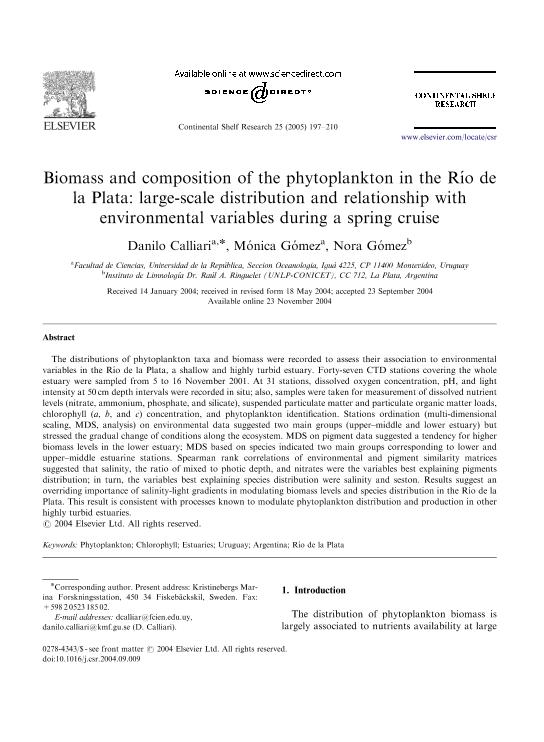Mostrar el registro sencillo del ítem
dc.contributor.author
Calliari, Danilo Luis

dc.contributor.author
Gomez, Monica

dc.contributor.author
Gomez, Nora

dc.date.available
2017-12-14T21:47:45Z
dc.date.issued
2004-11
dc.identifier.citation
Calliari, Danilo Luis; Gomez, Monica; Gomez, Nora; Biomass and composition of the phytoplankton in the Río de la Plata: large-scale distribution and relationship with environmental variables during a spring cruise; Elsevier; Continental Shelf Research; 25; 2; 11-2004; 197-210
dc.identifier.issn
0278-4343
dc.identifier.uri
http://hdl.handle.net/11336/30708
dc.description.abstract
The distributions of phytoplankton taxa and biomass were recorded to assess their association to environmental variables in the Río de la Plata, a shallow and highly turbid estuary. Forty-seven CTD stations covering the whole estuary were sampled from 5 to 16 November 2001. At 31 stations, dissolved oxygen concentration, pH, and light intensity at 50 cm depth intervals were recorded in situ; also, samples were taken for measurement of dissolved nutrient levels (nitrate, ammonium, phosphate, and silicate), suspended particulate matter and particulate organic matter loads, chlorophyll (a, b, and c) concentration, and phytoplankton identification. Stations ordination (multi-dimensional scaling, MDS, analysis) on environmental data suggested two main groups (upper–middle and lower estuary) but stressed the gradual change of conditions along the ecosystem. MDS on pigment data suggested a tendency for higher biomass levels in the lower estuary; MDS based on species indicated two main groups corresponding to lower and upper–middle estuarine stations. Spearman rank correlations of environmental and pigment similarity matrices suggested that salinity, the ratio of mixed to photic depth, and nitrates were the variables best explaining pigments distribution; in turn, the variables best explaining species distribution were salinity and seston. Results suggest an overriding importance of salinity-light gradients in modulating biomass levels and species distribution in the Río de la Plata. This result is consistent with processes known to modulate phytoplankton distribution and production in other highly turbid estuaries.
dc.format
application/pdf
dc.language.iso
eng
dc.publisher
Elsevier

dc.rights
info:eu-repo/semantics/openAccess
dc.rights.uri
https://creativecommons.org/licenses/by-nc-nd/2.5/ar/
dc.subject
Phytoplnkton
dc.subject
Chlorophyll
dc.subject
Estuaries
dc.subject
Uruguay
dc.subject
Argentina
dc.subject.classification
Biología Marina, Limnología

dc.subject.classification
Ciencias Biológicas

dc.subject.classification
CIENCIAS NATURALES Y EXACTAS

dc.title
Biomass and composition of the phytoplankton in the Río de la Plata: large-scale distribution and relationship with environmental variables during a spring cruise
dc.type
info:eu-repo/semantics/article
dc.type
info:ar-repo/semantics/artículo
dc.type
info:eu-repo/semantics/publishedVersion
dc.date.updated
2017-11-03T20:15:40Z
dc.journal.volume
25
dc.journal.number
2
dc.journal.pagination
197-210
dc.journal.pais
Países Bajos

dc.journal.ciudad
Amsterdam
dc.description.fil
Fil: Calliari, Danilo Luis. Universidad de la República; Uruguay
dc.description.fil
Fil: Gomez, Monica. Universidad de la República; Uruguay
dc.description.fil
Fil: Gomez, Nora. Consejo Nacional de Investigaciones Científicas y Técnicas. Centro Científico Tecnológico Conicet - La Plata. Instituto de Limnología "Dr. Raúl A. Ringuelet". Universidad Nacional de La Plata. Facultad de Ciencias Naturales y Museo. Instituto de Limnología; Argentina
dc.journal.title
Continental Shelf Research

dc.relation.alternativeid
info:eu-repo/semantics/altIdentifier/doi/http://dx.doi.org/10.1016/j.csr.2004.09.009
dc.relation.alternativeid
info:eu-repo/semantics/altIdentifier/url/http://www.sciencedirect.com/science/article/pii/S0278434304002365
Archivos asociados
